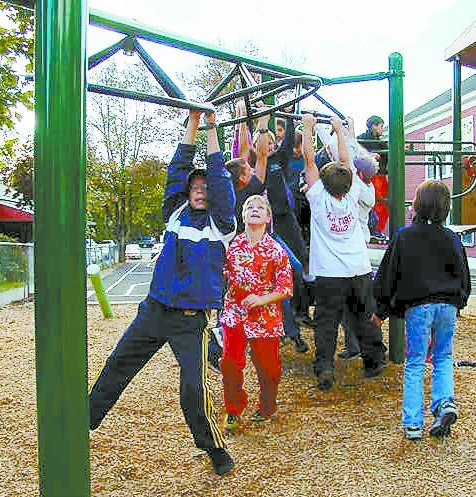Imagine yourself in a workplace, doing a 6.5-hour shift in a room with upwards of 20 other workers. The windows are rarely opened and the HVAC system is subpar. You must ask your supervisor’s permission to use the bathroom. There’s 30 minutes for lunch and one other 20-minute break at the discretion of your supervisor. If you’re seen as underperforming, that break is revoked – with no grievance procedure.
Now imagine you’re a child in this setting. That’s where many of our children or grandchildren go, 180 days a year.
Why do our schools deny children the essential breaks deemed vital to maintaining mental alertness among pilots, truck drivers and unionized workers? How sustainable is an educational system that doesn’t meet children’s innate need for energetic movement and free play?
U.S. school districts have been whittling down recess time for more than a decade, spurred on by the 2001 No Child Left Behind Act. As schools began to be judged and penalized according to students’ standardized test scores, teachers and administrators felt compelled to pack in maximal instruction time. Many districts have come to see recess as wasting precious time that would be better spent mastering academic standards. A 2010 survey by the Maine Department of Education found that 61 percent of responding schools were down to a single recess each day, with roughly half the schools providing only 16-25 minutes of recess..
The exclusion of play breaks during school makes for stressed, restless kids and beleaguered teachers. And, ironically, this tough-love commitment to boost academic accountability by cutting recess has no grounding in empirical research.
What repeated studies show is that recess helps kids recalibrate their minds and bodies, making them more focused and effective learners. After examining related research, the American Academy of Pediatrics (AAP) issued a policy statement in 2012 entitled The Crucial Role of Recess in School. “Cognitive processing and academic performance depend on regular breaks from concentrated classroom work,” the AAP concluded, noting that this need to decompress mentally applies “equally to adolescents and young children.” Recess “offers cognitive, social, emotional and physical benefits,” it added, and is “a crucial and necessary component of a child’s development” that “should not be withheld for punitive or academic reasons.”
School administrators routinely honor physician’s notes when a doctor deems an activity ill-advised for a sick or injured child. So why do they ignore this collective prescription for a shift in scheduling that would improve children’s well-being and learning?
Many of the nations that top the charts in school test scores – like Finland and Japan – already follow this prescription. But despite ample research and international evidence demonstrating the multiple benefits of recess, there are no national or Maine state mandates requiring schools to provide it.
Given the relentless pressures of standardized testing, many teachers and administrators seek to get by with fewer and shorter recess breaks. They rationalize that physical education classes and walking between rooms provide exercise and a break from mental exertion. When I questioned the elimination of a second recess period in my child’s school, a teacher assured me that students instead get “three 90-second brain breaks” (stretching and movement activities in the classroom). Yet even the National Association for Sport and Physical Education admits that PE classes (and one must assume stretch breaks) are no substitute for “unstructured play opportunities.”
The more programmed and stressful the school day becomes, the more children need recess. It offers them fresh-air windows when they can decide whom they want to socialize with and what they want to do. Educational researchers affirm that what may look unpredictable and chaotic to passing adults is a creative environment offering enduring lessons in improvisation, cooperation and compromise. At recess, students learn how to lead, concede, innovate and resolve differences. Those capacities aren’t measured on standardized tests, but they’re essential life skills.
The children on today’s playgrounds will face daunting challenges in the decades ahead. Since free play strengthens them physically, mentally and psychically, we ought – like other enlightened school systems around the world – to devote at least an hour of each school day to recess.
Send questions/comments to the editors.



Comments are no longer available on this story